Jacky Tyrwhitt, Remembering an Extraordinary Woman

“The moment she walked into the office, I saw that she was not scary at all, but warm, delightful, funny, and kind. She was thin but wiry, and although her hair was white, she had the face of a sprite, lively and curious. She told me to call her Jacky. Had I known more about her, I would have been in awe.”—Diana Farr Louis
Eating Well Is The Best Revenge
By Diana Farr Louis
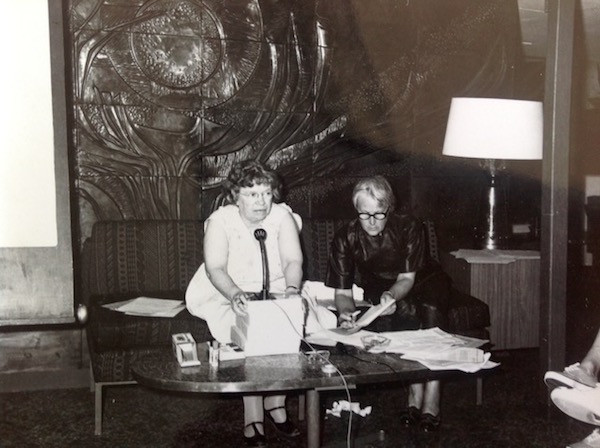
ATHENS Greece—(Weekly Hubris)—March 2020—A new job is always nervous-making, but it didn’t help when the young woman showing me around said, “You’ll be sharing an office with Miss Tyrwhitt. She’s quite strict, very British, and we’re a bit scared of her.”
I was going to be her assistant, production editor of the esoteric International Journal of Ekistics and the New Habitat: the problems and science of human settlements, which she and Constantine Doxiadis, the noted architect-planner, had founded in 1955, 20 years earlier. My only qualifications were native-speaker knowledge of English, and availability. The current editor was eight months pregnant and no one had thought of finding a replacement. We were in Athens, after all, and even highly educated, worldly Greeks are not always skilled at thinking ahead, especially when their minds are on the bigger picture.
It turned out that I would have to work in another language, planner-ese, almost as impenetrable as legalese, but I was good at spotting typos, correcting punctuation, and designing layouts, while Miss Mary Jaqueline Tyrwhitt took care of the content.
The moment she walked into the office, I saw that she was not scary at all, but warm, delightful, funny, and kind. She was thin but wiry, and although her hair was white, she had the face of a sprite, lively and curious. She told me to call her Jacky. Had I known more about her, I would have been in awe, but all she revealed at first, hearing that I’d graduated from Harvard, was that she had been Associate Professor of City Planning and Urban Design there, from 1955 to 1969, and we had overlapped. Doxiadis had urged her to retire in Greece and, finding the dry climate eased her asthma, she’d bought some land and built a very modern house on a hillside in Paiania, overlooking what is now Eleftherios Venizelos Airport.
That summer, we became friends, although she was twice my age, and I spent more and more time in Sparoza, where she was making a garden of solely Mediterranean plants, some native, some smuggled in from her frequent travels. I learned that her early training had been in horticulture, but that she’d switched paths to study urban planning in Germany and in London; traveled on her own on the Trans-Siberian Railroad to Moscow, Manchuria, and Shanghai; served in the Women’s Land Army during the war; and then taken the job she was most proud of—developing correspondence courses for servicemen so that they could jump-start their education in town and regional planning when it was over. They were to attract 1,600 students.
I also learned that, after the war, she’d worked with everyone in the modern architectural/planning scene, from Le Corbusier to Bucky Fuller (who had designed a small geodesic dome that sat at the bottom of her property). But she never talked about them, or her role in the inner core of CIAM (Congrès Internationaux d’architecture moderne), introducing ideas and being responsible for reports, or her work with UNESCO, or as the “ghost writer” for Siegfried Giedion, CIAM’s Bohemian-born Swiss secretary and an influential critic of art and architecture, who wrote eight books in “unusual English” that Jacky essentially rewrote before they were published.
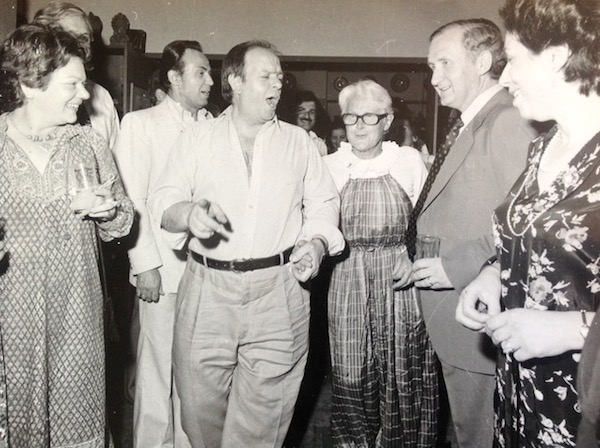
That was only the tip of the iceberg and, because of her remarkable lack of ego, I would only learn about the rest of her considerable accomplishments after her death. She never talked about her personal life, either, her loves or why she’d never married, but her youthful, witty, and thoughtful presence was enough for me.
This was a friend who would give my eight-year-old son a jar full of tadpoles from one of her ponds at Sparoza, and then call to find out how they were doing. When I said we’d made the mistake of changing the pond water with chlorinated tap water and that they’d all died, she was so upset at thinking how sad he must be that, the next day, she took the trouble to deliver a new jar of tadpoles to the office, although she was flying out to Vancouver for a Habitat conference a few hours later.
This was a woman who would drive her Deux Chevaux through a blizzard to hear me sing in a concert—in the choir, not a solo—and who would scoff when my son, asked to guess her age, said “Fifty?” Jacky retorted, “That’s probably as high as he can count!” She did not let rules stand in her way, either. At the Harvard Faculty Club, when the doorman protested that “Ladies were not permitted,” she simply brushed him aside, saying “What makes you think I’m a lady?”
Jacky was also a stoic. I remember one Monday morning she appeared at the office and happened to mention that the traffic had been so awful Sunday evening that it had forced her car off the road and into a ditch. Even though battered and bruised, she’d managed to get the car towed and thought nothing of coming into work, even though, at over 70, she was well past retirement age.
One of her great talents was mixing her Athenian/international intellectual friends with her neighbors in Paiania, still country folk in those days. Every Clean Monday, the start of Greek Lent, she would hold an open house, and scores of people of all ages would turn up to fly their kites and eat delicious fasting foods. (Jacky was not a cook, however, so we would all bring contributions.) There you would find many colleagues from Doxiadis Associates, musicians from the Contemporary Music Society, and families from the village, some of whom were her students, for she gave a few English lessons. Flying a kite incurred the risk that her goat, Clara, would bring it down; she loved munching on kite twine!
We in turn would invite her to beach parties and Easter lamb roasts in Maroussi, but the party that sticks in my memory was her 75th—see the two photos—held at Panayis Psomopoulos’s house in Athens in 1980. Panayis, a character, himself, and the ruler of Doxiadis Associates’ Athens Center of Ekistics, had invited half the company. Jacky was tickled pink, as you can see.
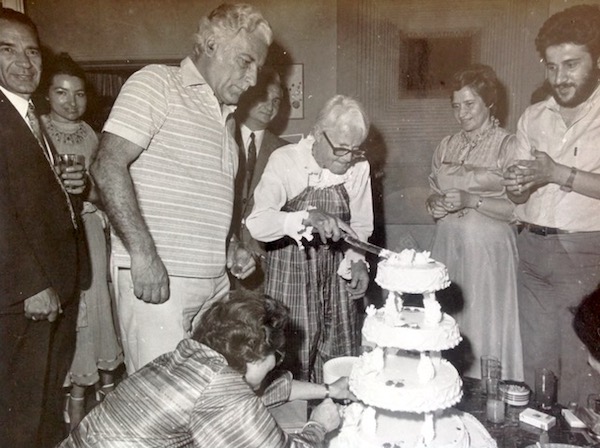
Three years later, she would be dead, from complications caused by the heavy doses of cortisone she was prescribed to combat her asthma. Her diary shows that she was working on the next issue of Ekistics until the day before, even though in great pain from a fractured rib.
As we struggled to cope with our grief, her family, who had flown to Greece for the funeral, eased it somewhat by holding an open house and letting her friends choose from among some of her belongings items that would remind them of Jacky. I picked a handsome celadon bowl and a Japanese “house” jacket, which I still wear in summer instead of a bathrobe. And then her niece, Catharine Huws Nagashima, and I were entrusted with preparing/compiling an In Memoriam issue of Ekistics. It took us two years, as there were so many people who wanted to contribute; so many stories and photos to put together.
Looking through it now brings back many memories, but reminds me too of how little I knew about this extraordinary person. Just the tip of a very warm “iceberg.” One thing, though: as I went through her diaries, I discovered that she had never had a bad word to say about anyone, even to herself. Most of the entries had to do with work, her garden and her plants, and the book she was working on: Making a Garden on a Greek Hillside.
The book, which would not see publication until 1998, describes how she turned a windswept hill with a few “sheep-nibbled bushes” into a garden, with chapters organized by month: events, jobs, fauna, climate, and flora, with a full description of the plants in bloom, native and introduced. March, for example, includes 55 native species and 13 introduced, with their Latin and common names and a few drawings.
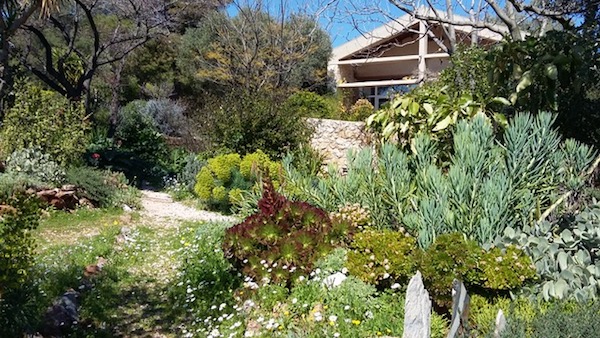
Her other project, the garden at Sparoza, itself, is very much alive. Jacky left it to the Goulandris Museum of Natural History in Kifissia and, under the care of another exceptional and modest woman, Irish-born Sally Razelou, it is more beautiful than ever. It has been the headquarters of the Mediterranean Garden Society, which now has members in more than 40 countries, since its founding in December 1994. Whenever I go there, I almost think I see Jacky behind a shrub, delightedly watching her “baby” inspire so many people with joy and appreciation of Nature.
In Sparoza, her last work, the Mediterranean Garden Society has a living memorial to this citizen of the world who never lost her love of the land and its plants.
As far as I know, there is only one biography of Jacky: Jaqueline Tyrwhitt: A Transnational Life in Urban Planning and Design (Design and the Built Environment), by Ellen Shoshkes.
Shoshkes’s conclusion could not be truer: “[Jacky’s] garden at Sparoza, a living work of art, survives as a lasting tribute to the intellectual, professional, and personal contributions she made throughout her remarkable life.”
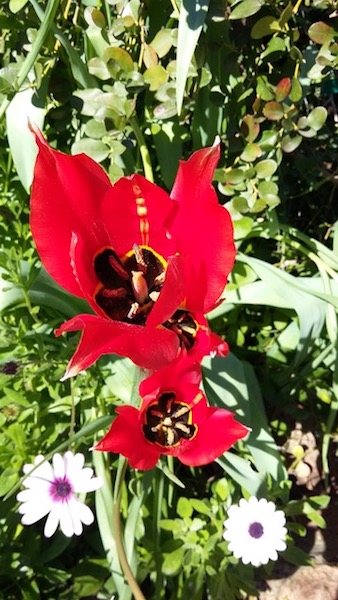
Recipe
Tangerine Truffles
I was tempted to add my recipe for taramosalata to this column, since that is what we’ll be eating a lot of here in Greece during Lent, which starts on March 2, and which I might have taken to Jacky’s Clean Monday parties, but you can find that here.
Instead, I offer very simple instructions for tangerine “truffles.” A friend came over the other day with a large bag of tangerines picked from her own trees on an estate not far from Sparoza.
She reminded me of this treat, which is reproduced here from my book, Feasting & Fasting in Crete. I first encountered these delicacies in Chania, where an acquaintance made them for her daughter’s wedding. They make a lovely present, too, and freeze well if you want to put temptation at a (short) distance and nibble them in increments.
In Greece, we would use what they call Chios mandarins, but they are simply the yellowish tangerines I knew as a child, not the more exotic orangey clementines, which I tasted for the first time in Paris a hundred years ago. Today, people seem to favor clementines because they have few pips, but I rate tangerines higher in aroma and deliciousness.
Use only organic fruit when you make this.
You will need:
Peel from 30 unblemished tangerines
450 grams (1lb) sugar
450 grams (1 lb) almonds, blanched and ground in food processor
Boil the tangerine peels in lots of water (to get rid of their bitterness) until they are soft. Drain. Leave them to dry overnight, wrapped in a big dish towel.
The next day, crumble the peel between your fingers until you have a “puree” of tangerine peel. Put the peel and the sugar in a large saucepan and boil, stirring with a wooden spoon, until the sugar turns to syrup. Be careful not to let it burn. Remove the pan from the burner, stir in the ground almonds, and mix thoroughly.
When cool, pinch off bits of the mixture, roll it into little balls, and arrange them on a pretty platter.
If you are not going to use the “truffles” within the next day or two, lay them between sheets of wax paper and store them in the freezer. Makes about 60 pieces. You can, of course, halve the recipe.
![]()
Editor’s Note: If you’re unfamiliar with “ekistics,” Wikipedia’s entry is a good place to start.
![]()
To order the paperback book, click on the book cover below:


3 Comments
Will
What a magical encounter – and one to color your whole life! Jacky must have been wonderful! And as the creator of the gardens at Sparoza, her reach extends through distance and time. A wonderful remembrance of a wonderful woman! Thanks, Diana. (BTW, how large are the ‘little balls’ ideally to make a perfect bite of tangerine truffle? They sound incredibly delicious!)
Diana
Hi Will, you would have loved her and you will love Sparoza. I know you’ll make it here one day. The tangerine truffles can be as large as you want but probably should be a bit smaller than a walnut. Like a chocolate truffle. Kali orexi. (enjoy them). xox
Don
What a lovely profile. You show what a fascinating, generous and worldly person Jacky was. And what a testimony to her that her garden at Sparoza is still being tended.